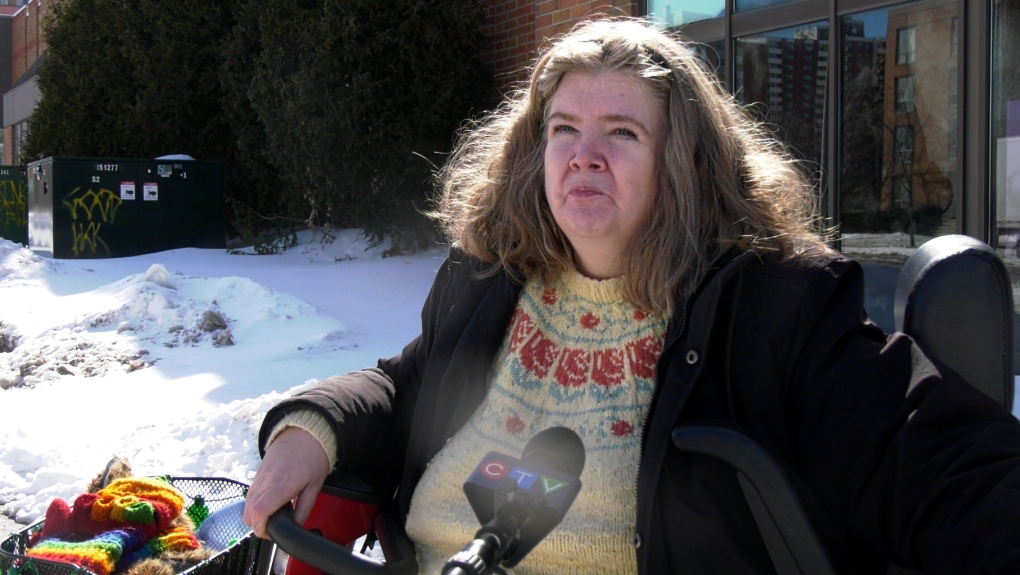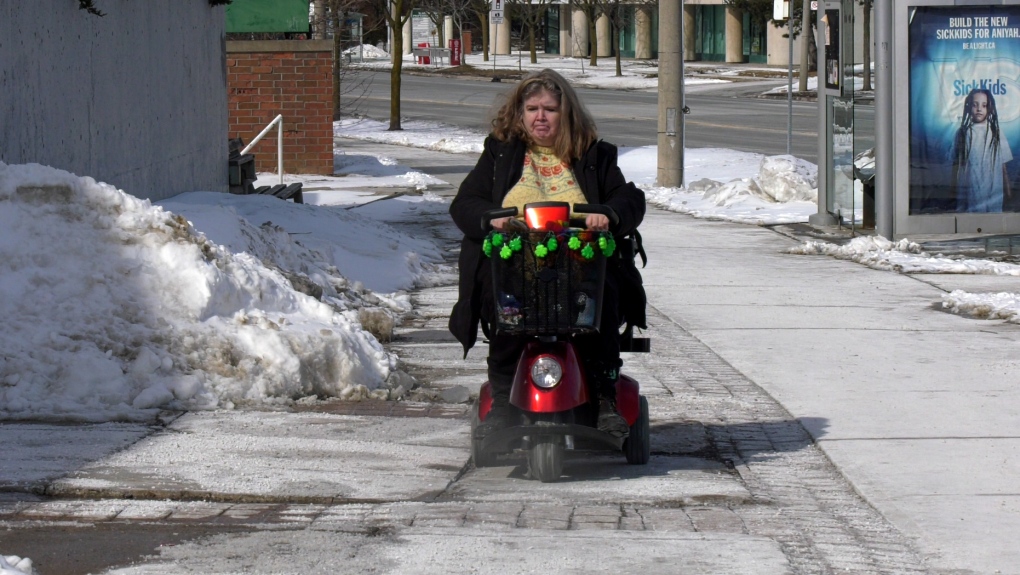Toronto woman who suffered concussion after fall from mobility scooter says city snow clearing protocols need review
A Toronto woman she says fell from her mobility scooter and got a concussion due to a poorly cleared sidewalk while trying to get groceries about ten days after the city saw a major snowfall in January.
Susan Hutchinson is calling for city crews to prioritize people with disabilities in the clearing of snow and make sure that when they do clear the path, what they leave behind is accessible — a recommendation echoed by a city committee this month.
“The sidewalk wasn’t cleared and I was going over really rough terrain,” she said. She said she was headed to get groceries near Malvern Town Centre on Jan. 28.
Hutchinson said she was following the path of a city plow that had veered off course and onto the uneven pavers on the mall’s property. She said her wheels slipped and she tumbled out of the scooter, receiving a concussion from the fall.
“It was sheer panic. I already have a spinal disability. I was nearly paralyzed once. My first thought was, ‘Cover my head.’”
 Susan Hutchinson (Jon Woodward/CTV News Toronto)
Susan Hutchinson (Jon Woodward/CTV News Toronto)
The City of Toronto confirmed it received a complaint from Hutchinson about her fall.
“The Municipal Licensing and Standards is investigating and addressing the damaged condition of the cobblestone path and concrete sidewalks, which are on private property. Since this is an ongoing investigation, additional information cannot be provided at the moment,” a city spokesperson said in a statement to CTV News Toronto.
The statement said all property owners are required to repair and maintain their property, and clear ice and snow within 24 hours after snowfall ends. Malvern Town Centre didn’t respond to inquiries from CTV News Toronto.
The City of Toronto previously said crews and contractors were working 24 hours a day to dig the city out of the January snowfall, which was the most snow seen in at least a decade. Cold weather meant the snow did not melt, and so tens of thousands of tonnes had to be trucked away.
 Susan Hutchinson (CTV News Toronto)
Susan Hutchinson (CTV News Toronto)
After the snowfall, those with mobility challenges had to make a choice: take the risk of going outside in a potentially hazardous situation or stay home.
“It was almost impossible,” Jean Williamson, who uses a mobility scooter, told CTV News Toronto Monday. “This is the first time in six weeks I’ve been able to get out on my own.”
Toronto’s Accessibility Advisory Committee is calling for the city to target areas that people with mobility issues or seniors use, to respond quickly to service requests even during “black-out” periods, and to have standard levels of service for major winter storms that leave huge amounts of snow.
“Rather than let it be chaotic or undefined when it comes to 35 cm of snow or 50 cm of snow, determine how long it’s going to take. Do the math, figure it out and get it done. Don’t leave us waiting for weeks on end,” committee chair and Toronto city councillor Kristyn Wong-Tam said in an interview with CTV News Toronto.
According to a committee presentation, city officials had prepared for four storm types. Storm type 1 is under 5 cm of snow, storm type 2 is between 5 and 15 cm, storm type 3 is between 15 and 25 cm and storm type 4 is over 25 cm.
The committee recommended that the 2023 budget process ensure the city can meet revised levels of service for two new categories — above 35 cm of snow and above 50 cm of snow.
It also recommended that the city target certain areas in the way Sweden targets daycares, schools and other areas in what that country calls a “Gender Equal Plowing Strategy.”
“What that does is prioritize vulnerable road users and sidewalk users,” Wong-Tam said.
“They created a program where all municipalities clear a pathway to daycares, schools, and transit stops first. Right now we go the other way, we take care of the cars first and the people last.”
CTVNews.ca Top Stories

Doctors ask Liberal government to reconsider capital gains tax change
The Canadian Medical Association is asking the federal government to reconsider its proposed changes to capital gains taxation, arguing it will affect doctors' retirement savings.
Keeping these exotic pets is 'cruel' and 'dangerous,' Canadian animal advocates say
Canadian pet owners are finding companionship beyond dogs and cats. Tigers, alligators, scorpions and tarantulas are among some of the exotic pets they are keeping in private homes, which pose risks to public safety and animal welfare, advocates say.
WATCH LIVE Toronto police to release updated list of most wanted fugitives in Canada
Toronto police and law enforcement partners will be releasing the BOLO program’s updated list of the top 25 most wanted fugitives in Canada at a news conference on Tuesday morning.
Prince William and wife Kate thank public for birthday messages for son Louis
Prince William and his wife Kate thanked the public for their messages which had been sent to mark the sixth birthday of their youngest son Louis on Tuesday.
She was the closest she'd ever been to meeting her biological father. Then life dealt her a blow
Anne Marie Cavner was the closest she'd ever been to meeting her biological father, but then life dealt her a blow. From an unexpected loss to a host of new relationships, a DNA test changed her life, and she doesn't regret a thing.
How quietly promised law changes in the 2024 federal budget could impact your day-to-day life
The 2024 federal budget released last week includes numerous big spending promises that have garnered headlines. But, tucked into the 416-page document are also series of smaller items, such as promising to amend the law regarding infant formula and to force banks to label government rebates, that you may have missed.
Fire engulfs old Edmonton municipal airport hangar
A historical hangar at the former Edmonton municipal airport beside the NAIT main campus was on fire Monday night.
RCMP uncovers plot to sell drones and equipment to Libya
The RCMP says it has uncovered a ploy to sell Chinese drones and military equipment to Libya illegally.
Which foods have the most plastics? You may be surprised
'How much plastic will you have for dinner, sir? And you, ma'am?' While that may seem like a line from a satirical skit on Saturday Night Live, research is showing it's much too close to reality.
































